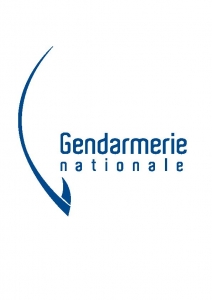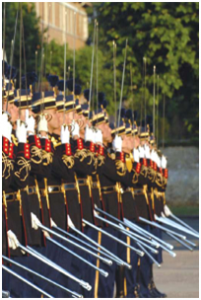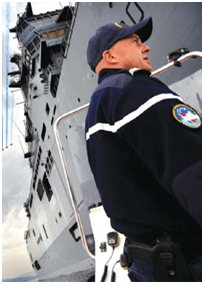The Gendarmerie nationale is one of France’s oldest institutions. It is the natural heir to the Royal Constabularies « Maréchaussée de France », i.e, the military forces which remained the only corps in charge of policing the country for centuries. Initially in charge of judicial and police missions to control scaterred soldiers and looters, the scope of their competence was progressively extended during the Renaissance to general policing. The creation of the Gendarmerie nationale « units » – forming the basis of the current organisation – dates back to 1720.
In 1791, the “Maréchaussée” was renamed Gendarmerie nationale. The Act dated « Germinal 28, Year VI of the French Revolution » (April 17, 1798) established the principles of action, missions and assignments in terms of general and judicial police.Today, the Gendarmerie nationale ensures public safety on 95 % of the national territory for 50 % of the population. Twenty-four hours a day, the institution protects, rescues, intervenes, investigates, arrests and fights.
– Judicial missions
Competent all over the national territory, in towns as well as in the countryside, more than a quarter of the tasks of the Gendarmerie is devoted to judicial duties. The ability to find information, the modern means of data processing, the training of personnel in judicial matters and in the investigation techniques are assets that enhance its effectiveness in judicial police. In the Gendarmerie departmentale units (territorial squads, investigation units) nearly 61,000 gendarmes, including 26,000 judiciary police (law enforcement) officers lead investigations in important fields such as drug trafficking, murders, aggravated thefts, financial affairs but also and mainly in more common affairs like burglaries, car thefts, fraud….
For twenty years, the national Gendarmerie has been putting in place highly skilled professionals in terms of criminal investigation, and developing its capacity in terms of forensics. The setting up of the Documentation and judiciary research technical department (aka STRJD) in 1975, of the Judicial police national training centre (aka CNFPJ) in 1987, of the French Gendarmerie Forensic Research institute (aka IRCGN) in 1990 and the Judicial Pôle of the National Gendarmerie in 2015 gave concrete expression to this will.
– Administrative missions
This task is characterised by its preventive aspect. It is based on a continuous surveillance of the areas where the Gendarmerie is in charge of public security, particularly through contacts with the population. More than 40 % of its activities are devoted to this mission of protection of people and properties. Maintaining a reassuring presence all over the territory is therefore the objective of all territorial units that are often backed by mobile units, especially in summer.
– Military missions
Even in peacetime, the Gendarmerie takes part in the protection of particularly important places that can be of vital interest for the nation. It exercises the government control over the nuclear armament and provides the escorts of the nuclear weapons convoys. Moreover, it contributes to the preparation of the mobilisation of sister units and to the management of the reserves. Finally, the Gendarmerie accompanies the French armed forces stationed or committed abroad (military criminal police) and is takes part in peace missions (both military and civilian) all over the world, at the request of the EU, the United Nations, or the NATO.
In time of crisis or war, the strength of the Gendarmerie can be more than doubled with reserve units. Its ability to decentralised action, its presence near vital structures, its means of communication make the Gendarmerie one of the main factors in the operational defence of the territory.
Organizational structure
In 1950 (Decree of 6 January), the Gendarmerie was placed under the direct authority of the Ministry of Defence. The organization, personnel management and defence missions were answerable to the Ministry of Defence. In 2002 (Decree of 15 May), the Institution was also placed under the authority of the Ministry of Interior. Article 3 stipulated that regarding homeland security missions, the Ministry of Interior is responsible for the use of Gendarmerie nationale units. For this purpose this Ministry, in conjunction with the Ministry of Defence, defines the missions of the units other than the ones related to criminal investigations (which are under the ministry of Justices responsibility). It sets up a guideline regarding these missions and their implied organization.
On July 1, 2005, the Gendarmerie nationale reorganized its chain of command, thus fitting with the 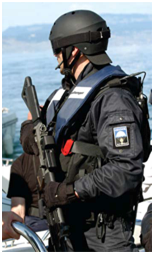 State’s reform process. It is now organized into 22 regions matching with the 22 administrative ones.
State’s reform process. It is now organized into 22 regions matching with the 22 administrative ones.
On August 3, 2009 , a new Bill attached the budget and the staff management of the Gendarmerie to the Ministry of Interior.
Each regional commander is responsible for the units located in his region and is directly subordinated to the Gendarmerie nationale general directorate. The Gendarmerie mobile units are now subordinated to the regional commander who deals with the Gendarmerie forces in the whole defence zone.
Territorial Gendarmerie
Favouring the contact with the population, the territorial Gendarmerie (Gendarmerie départementale) contributes to the general public security.
The territorial Gendarmerie includes
– Territorial units:
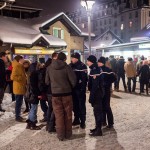 The Groupement is the commanding echelon at the level of a “département” (division of the French administrative organisation, smaller than a region). The Groupement is subdivided into companies. In general, we can find one company of Gendarmerie departementale by “arrondissement” (ie. district level : division of the French administrative organisation, smaller than a departement). Commanded by officers, the companies are divided into territorial brigades spread on the territory according to a logic of proximity. Territorial brigades can function in an autonomous way or be organised in communities of brigades (joint brigades).
The Groupement is the commanding echelon at the level of a “département” (division of the French administrative organisation, smaller than a region). The Groupement is subdivided into companies. In general, we can find one company of Gendarmerie departementale by “arrondissement” (ie. district level : division of the French administrative organisation, smaller than a departement). Commanded by officers, the companies are divided into territorial brigades spread on the territory according to a logic of proximity. Territorial brigades can function in an autonomous way or be organised in communities of brigades (joint brigades).
– Specialized Units :
the action of the territorial units is completed by the action of units with particular vocation :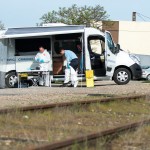
- Criminal investigation units (aka SR and BR): at district, département or region levels. These units are exclusively devoted to criminal investigations and judicial support to the territorial units ;
- Surveillance and intervention platoons (aka PSIG) : located in the most sensitive areas in terms of delinquency, they are dependent on the companies. They are in charge of backing up the territorial units, whatever the operational needs may be ;
- Juvenile crime prevention units (aka BPDJ) : at département level, they intervene in sensitive suburban areas and focus on youngsters facing difficulties ;
- Traffic units : at département and company levels, motorcyclist units, highway patrols, rapid response and motorway platoons ensure policing on the whole road network ;
- Mountain units (aka PGHM) : are responsible for the surveillance and the interventions (crime policing and rescue) in mountain areas ;
- Potholing units, at national level, are dedicated to underground investigations and rescues ;
- Air sections intervene in helicopters ;
- Maritime units are in charge of the seashore and waterways;
Mobile Gendarmerie
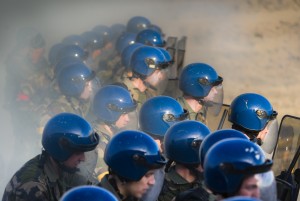 The mobile Gendarmerie is a 11,300 man strong general reserve at the disposal of the Government on the whole Metropolitan territory and French overseas territories. Responsible for maintaining public order, it is also shaped to respond to a wide range of missions, from policing events to restoring order.
The mobile Gendarmerie is a 11,300 man strong general reserve at the disposal of the Government on the whole Metropolitan territory and French overseas territories. Responsible for maintaining public order, it is also shaped to respond to a wide range of missions, from policing events to restoring order.
The mobile Gendarmerie is divided into group units and squadrons.
– The group units gathers from 4 to 7 squadrons.
– The squadron, mobile Gendarmerie basic unit, comprises around 105 officers and NCOs. It is structured in 4 platoons.
The Gendarmerie nationale intervention group (aka GIGN)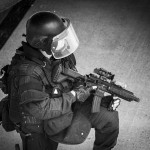
This Gendarmerie elite unit can be deployed over the national territory or abroad. It participates in special operations launched on the occasion of some serious events (e.g. terrorism, crime, hostage taking, riots in prison). It was particularly involved in the January 2015 terrorists attacks in Paris.
The Republican Guard
 Its missions are to protect government, national institutions and highest State authorities and to ensure honour services.
Its missions are to protect government, national institutions and highest State authorities and to ensure honour services.
It includes :
- Two infantry regiments ;
- One cavalry regiment ;
- Several special formations : orchestras, French army chorus, military music band, cavalry regimental band, motorcycle squadron.
Special Branches
– The maritime Gendarmerie
Is responsible for policing military harbours, naval base dockyards and facilities. It also contributes to the surveillance of the coast and to sea rescue.
– The air Gendarmerie
Is responsible for policing Air Force bases and compounds.
– The air transport Gendarmerie
Is responsible for public safety and law and air transport regulations enforcement in the most important civilian airports.
– The weaponry Gendarmerie
Operates for the French State organization in charge of weapon programs (a.k.a Délégation générale de l’armement or DGA) securing the facilities of the DGA. It can also be in charge of escorting weapons, ammunitions, explosives or any equipment and money transport coming from or going to a DGA facility.
Operational Reserve
The Reserve is composed of civilian volunteers and former members of the Gendarmerie. This Reserve is operational in peace time as well as in case of crisis. Reservists carry out the same missions as the active personnel, except tasks requesting specific technical skills related to criminal investigations. The Reserve is a back-up force, flexible, and can be called-up quickly.
The strength of the Reserve increased from 7,800 members in 2000, to 20,000 in 2006, and to 40,000 reservists in 2012.
Personnel
The Gendarmerie nationales personnel consists of both military (officers, NCOs and volunteers) and civilian staff (civil servants and state employees). The total staff reaches more than 98,000 people, including :
- 6,700 officers and 70,190 NCOs who perform operational missions ;
- 4,604 officers and NCOs from the technical and administrative services (aka CTA/CSTAGN);
- 13,900 volunteers, i.e. volunteer second lieutenants (aka AGIV) and assistant gendarmes (aka GAV) ;
- 2,700 civilian staff, i.e. civil servants, state employees and contract workers.
The Officers are decision-makers and have operational assignments.
The NCOs are security and crime investigation professionals who work close to the population.
The CTA/CSTAGN personnel’s specific duties can be administration, human resources management, housing, catering, mechanics, gunsmiths, printers …
The Assistant gendarmes are in charge of assisting NCOs. For the young population, being an assistant gendarme, provides first professional experiences and a springboard for possible future careers within the Institution.
Recruitment and training
– Recruitment: (to become a gendarme, see the following link : www.lagendarmerierecrute.fr )
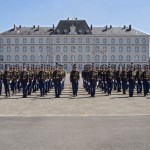 Applications files can be submitted all year long. Information concerning the careers can be obtained from the recruitment and information centres or from all the basic command units. For the NCOs, a competitive exam is organised twice a year, while the exam for officers takes place once a year.
Applications files can be submitted all year long. Information concerning the careers can be obtained from the recruitment and information centres or from all the basic command units. For the NCOs, a competitive exam is organised twice a year, while the exam for officers takes place once a year.
– Training :
Each year, among 30,000 personnel – from all ranks – are trained in one of the 6 national Gendarmerie training schools (located in Melun, Montluçon, Chaumont, Rochefort, Tulle, Châteaulin) or in one of the ten technical training centres (high studies, international training, foreign languages, criminal investigations, motorcycles, mountain, canine units, scuba diving or maintenance of law and order training centres). These centres were set up to perfect the training of the whole staff from the institution, whether they are specialists or not.
International relations
 In an international context where, far from our borders, the threats influence directly domestic security, the international co-operation must be increasingly efficient. In this respect, the Gendarmerie plays an essential role on the international scene.
In an international context where, far from our borders, the threats influence directly domestic security, the international co-operation must be increasingly efficient. In this respect, the Gendarmerie plays an essential role on the international scene.
At the European level, the EU constitutes the major framework of the international action of the Gendarmerie within the 3rd pillar “Police and judicial Cooperation in Criminal matters” (PJCC) and 2nd Politics pillar “common foreign and security policy” (CFSP). In this spirit, the Gendarmerie took an active part and contributed to the preparation of this great international appointment which constituted the French presidency of the European Union in the second half of 2008.
By the means of the European Commission financing the program “to prevent and fight against criminality” (ISEC), the Gendarmerie contributes as organizer or partner to European actions or seminars relating to topics linked to its fields of application (cyber-criminality, maritime pollution , training of integrated police units…). It also carries on technical assistance through the implementation of institutional twinning with the new Member States of the European Union (Lithuania, Bulgaria, Romania) or with countries, like Ukraine.
(programs TACIS and PHARE and now IPA and ENPI). As far as police co-operation is concerned, the Gendarmerie also registers its action on a worldwide scale through its participation in OIPC-Interpol. Lastly, other multilateral organizations (G8, UNO, the Council of Europe, African Union…) also requested the expertise of the Gendarmerie, in particular in the field of civil crises management.
At the international level, the Gendarmerie works in the direction of a greater police co-operation in order to strengthen our domestic security. Since 2002, it has been taking part, with the national police force, in the “single network” of homeland security attaches (ASI) within the French diplomatic representations abroad. This “single network” is placed under the authority of the International Cooperation Direction (DCI). In 2015, the Gendarmerie was providing 21 homeland security attaches and 10 homeland assistants security attaches (ASIA). It also deploys liaison officers.
Following the example of the liaison officer “itinerant criminality” within the Romanian ministry of interior, or the liaison officer affected within the general command of the Italian Carabinieri, a liaison officer “organized criminality” was posted in Malaga (Spain) in summer 2007 and another in April 2008 on the theme “fights against the narcotics” in Portugal, in Lisbon, within MAOC-N.
Lastly, since summer 2005, the Gendarmerie has been providing a senior officer, within the regional pole of fight against the criminality organized in the South East Europe, located in Zagreb (Croatia). This interdepartmental structure, created on the initiative of the Ministry for Foreign Affairs, allows the Gendarmerie to play an essential role in the fight against organized crime in the Balkans. The geographical priorities of the Gendarmerie meet the following criteria: geographical proximity (border countries), cultural proximity (FIEP countries), the return in domestic security (Balkans…) and countries where the institution can develop its model and its domains of excellence. In addition to its collaboration with the SCTIP, the actions of the Gendarmerie abroad are identified through a continuous dialogue with the Ministry for Foreign Affairs and the ministry of Defence. Each year, nearly 700 foreign trainees are trained in the schools and training centres of the Gendarmerie and more than 110 short term missions of experts or trainers of the Gendarmerie are carried ut abroad.
At the multinational level, the Gendarmerie is also very present abroad on theatres of operations: under the UN flag (FINUL in Lebanon, MINUK in Kosovo, MINUSTAH in Haiti, MONUC in democratic Republic of Congo, ONUCI in Ivory Coast…), the EU flag (MPUE and EUFOR in Bosnia, EUBAM Rafah in Palestine, EUPOL Kinshasa in DRC, EUPT in Kosovo), NATO flag (Afghanistan), or under national command (Ops Licorne in Ivory Coast and Epervier in Chad).
The website: https://www.gendarmerie.interieur.gouv.fr


